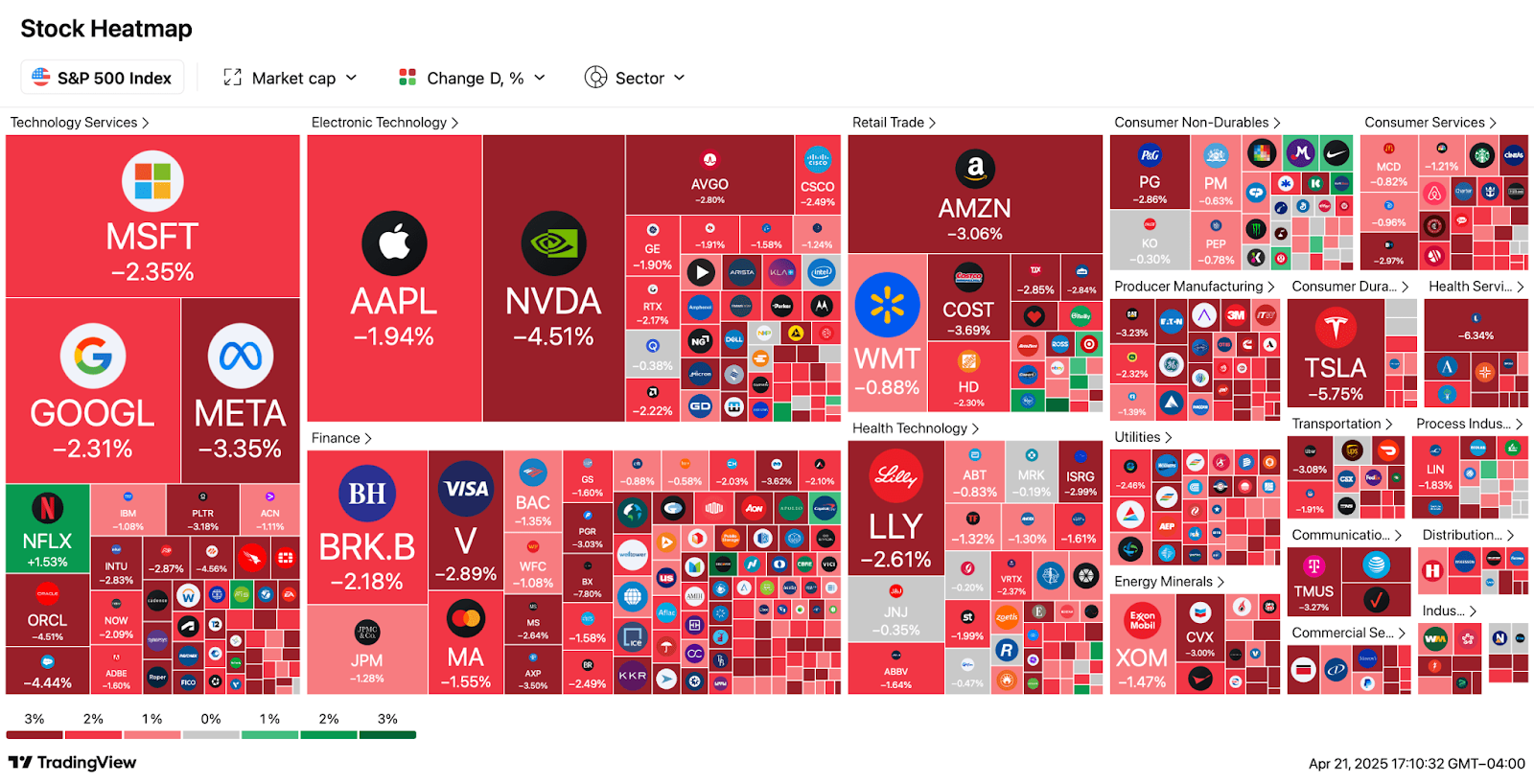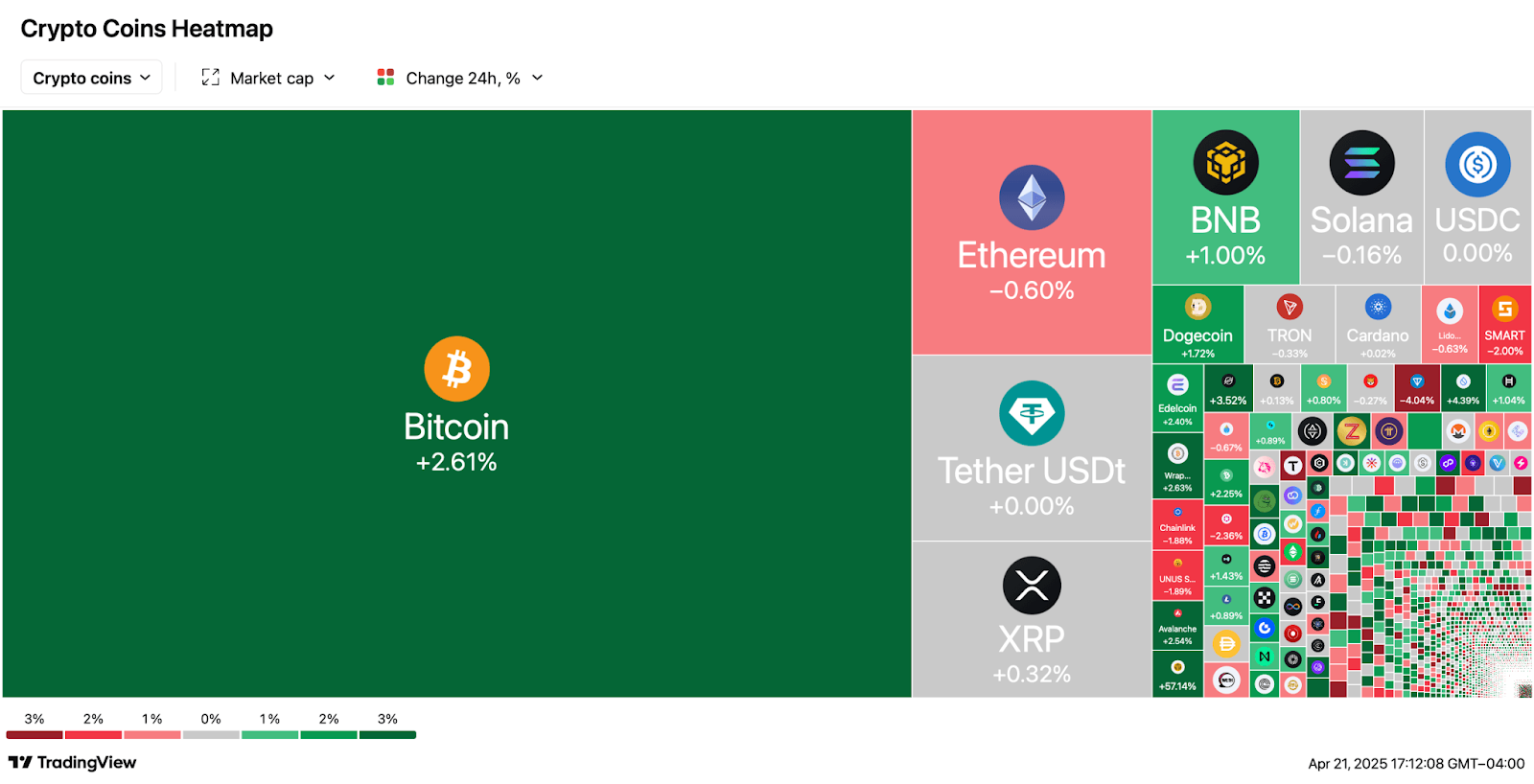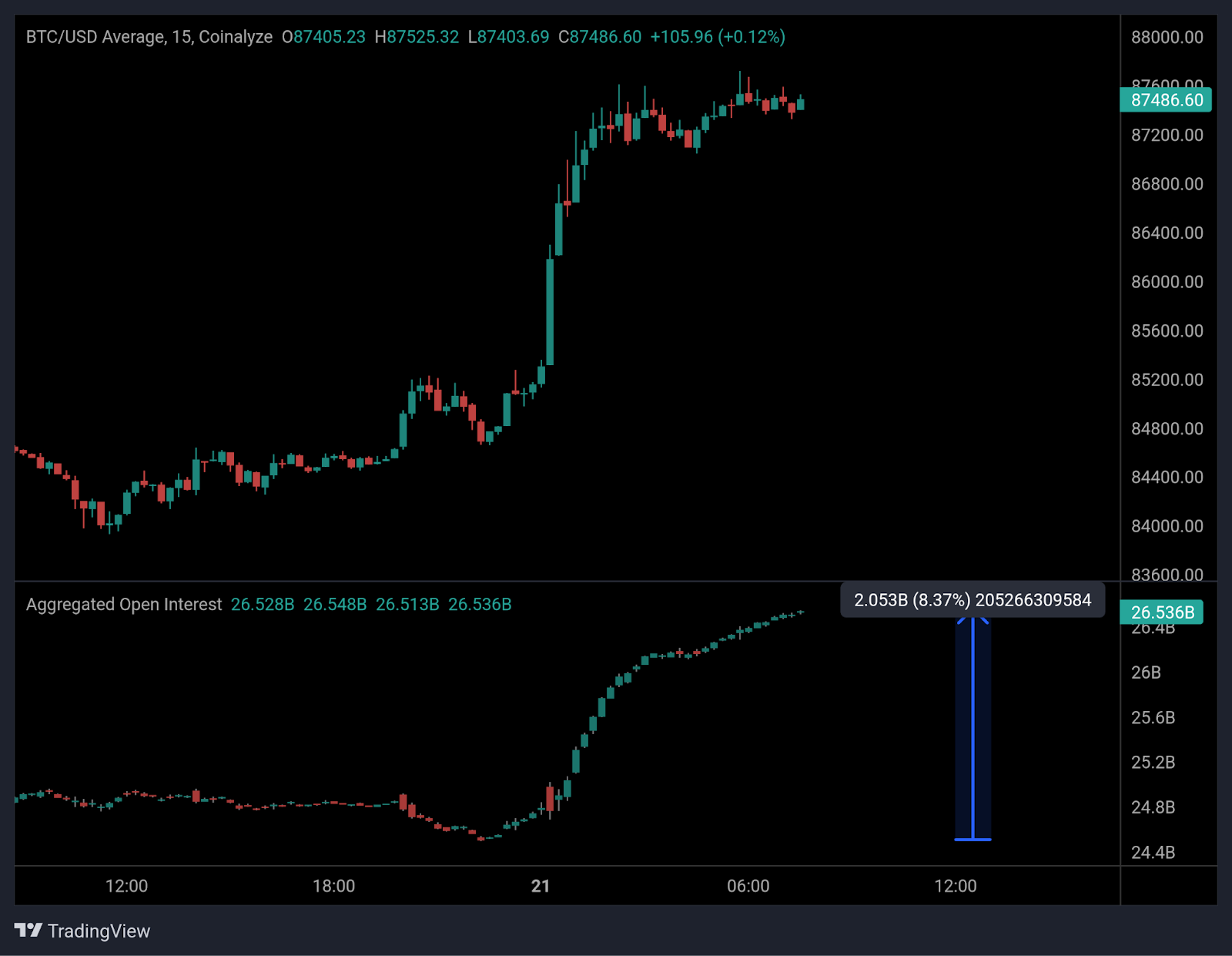
On April 21, 2025, the global financial markets experienced a "Black Monday". The three major US stock indices collectively collapsed: the Dow Jones Industrial Average plummeted 972 points (a 2.8% drop), the S&P 500 index plunged 125 points (a 3.1% drop), and the Nasdaq Composite index crashed 416 points (a 4.2% drop) due to a tech stock sell-off, with a single-day market value evaporation of $1.5 trillion.

However, in stark contrast to the traditional market's devastation, the cryptocurrency market grew by 1.77%, with a total market value breaking through $2.73 trillion. BTC once touched a high of $88,527 and ultimately closed at $87,262, with a daily increase of 2.61%. More notably, some alternative tokens like Convex Finance (CVX) surged 21.04% in a single day, Stacks (STX) rose 12.98%, and even meme coins like "FARTCOIN" recorded an 8.52% increase.
This phenomenon overturns traditional financial logic - why could Bitcoin, a typical risk asset, go against the tide during a "Risk-off" wave triggered by a US stock market crash? Behind this lies a complex game of US dollar credit crisis, geopolitical policy impacts, and crypto asset value reassessment.
Storm Center: How Will Trump's Tariff Policies Tear Apart the Global Market?
1. Trump 2.0's "Hundred Days Reformation" Policy Iron Fist
Since taking office in January 2025, the Trump administration, with "America First" as its core, has launched a series of radical policies:
- Comprehensive Tariff Escalation: Imposing up to 125% tariffs on Chinese goods exported to the US, canceling exemptions for goods under $800, and launching anti-circumvention investigations on key industries like semiconductors and new energy vehicles;
- "Reciprocal Tariffs" Impact: Imposing differentiated tax rates (up to 125%) on over 60 trade surplus countries, retroactive to April 5, covering core commodities like steel, aluminum, and automobiles;
- Supply Chain Restructuring: Mandating that the North American automotive supply chain's localization ratio increase to 75%, directly impacting tech manufacturing industries dependent on global division of labor.
These policies have caused global trade costs to soar. The WTO predicts that if tariffs continue until 2026, global trade volume may shrink by 25%, with the US recession probability exceeding 60%. Enterprises are forced to bear supply chain restructuring costs, with tech giants Apple and Tesla's market value evaporating over $300 billion.
2. US Dollar Credit Crisis: From "Safe Asset" to "Risk Source"
The chain reaction triggered by Trump's policies exposes the structural contradictions of the US dollar system:
- Debt Bomb: US Treasury bonds maturing in 2025 amount to $9.2 trillion, with interest expenditure accounting for 13% of fiscal expenditure, and tax cuts and tariff revenues unable to fill the deficit;
- Inflation Stickiness: Energy prices and tariffs push core CPI to 3.5%, with the Federal Reserve's rate cut expectations postponed to September, intensifying market concerns about "stagflation";
- De-dollarization Acceleration: 37 countries signed digital currency cooperation agreements, with Saudi oil yuan settlement proportion breaking through 25%, and CIPS transaction volume growing 47%.
In this context, investors begin to question the stability of the US dollar as a global reserve currency. Gold prices rose 3.28% in a single day to $3,425/ounce, with a monthly increase of 12%, but volatility rose from 1.2% to 1.8%, indicating that traditional safe-haven assets can no longer fully absorb market anxiety.
Decoupling Mystery: How Bitcoin Breaks Through Traditional Risk Frameworks
Collapse of Historical Correlation
The strong correlation between Bitcoin and tech stocks formed over the past five years (correlation coefficient of 0.78) is undergoing a qualitative change. Data from April 2025 shows that Bitcoin's 30-day correlation with Nasdaq has plummeted from 0.6 at the beginning of the year to 0.35, while gold's negative correlation with S&P 500 has strengthened to -0.42. This transformation peaked on April 21 - when tech stocks plummeted 4%, Bitcoin instead broke through key resistance levels.
Dual Reconstruction of Value Support
① Monetary Attribute Strengthening: The Federal Reserve's overnight reverse repurchase scale broke through the historical peak of $2.3 trillion, indicating that US dollar liquidity is being systematically extracted. With Bitcoin's absolute scarcity of 21 million coins, it becomes the first choice for value storage when US dollar credit is damaged. Bitwise analyst Juan Leon points out: "When government agency credibility drops below the critical point, Bitcoin's algorithmic credit begins to show comparative advantages".
② Institutional Position Transformation: MicroStrategy now holds 500,000 Bitcoins, accounting for 2.38% of circulation, and BlackRock's Bitcoin ETF management scale has exceeded $30 billion. Unlike retail investors' short-term trading, these institutional investors adopt a "strategic reserve" mode, essentially incorporating Bitcoin into their balance sheets for long-term allocation.

Over the past day, open interest increased by over $2 billion, equivalent to a percentage increase of more than 8.3%. Here, "open interest" is an indicator measuring the total current outstanding BTC-related positions across all derivatives exchanges.

In the last 24 hours, 103,496 people globally were liquidated, with a total liquidation amount of $276 million. From the current sentiment indicators, Bitcoin has emerged from the panic sentiment of the past two weeks.
Conclusion: Finding Light in the Cracks of Order
The financial storm of 2025 exposes the fragility of the traditional fiat currency system and the backlash effect of unilateral policies. Bitcoin's counter-trend rise is not only a release of market sentiment but also a collective vote by global investors for a supranational value storage method. Just as the collapse of the Bretton Woods system in 1971 gave birth to a gold bull market, today's US dollar credit crisis may become a turning point for crypto assets to take the historical stage.
However, this transformation will not happen overnight. Investors need to be wary of bubbles in market fluctuations, focus on underlying technological progress and regulatory compliance, to capture the true value dawn in the wave of order reconstruction.







